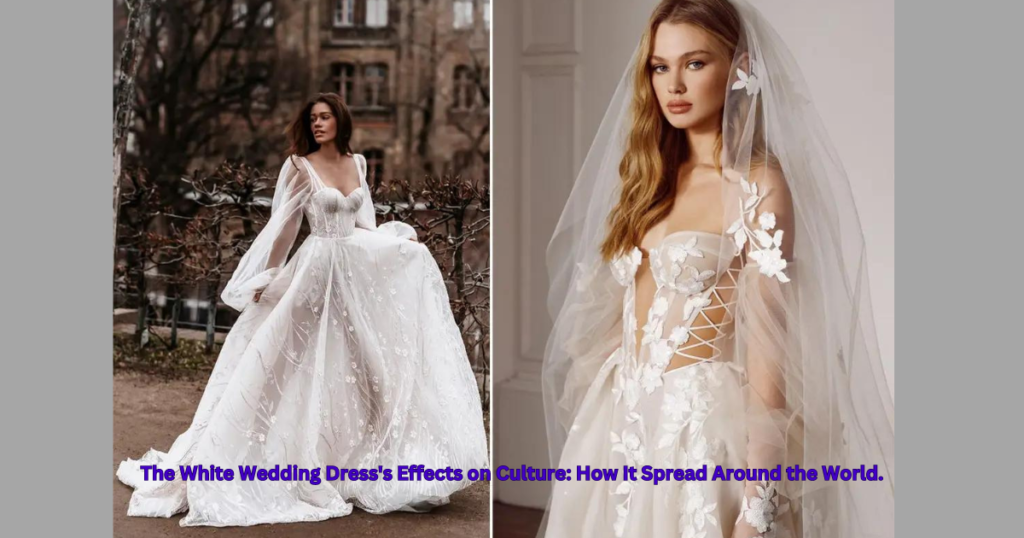Stories about royalty and fashion often go hand in hand, and Queen Victoria’s influence on fashion will last long. With her rule over the British Empire for most of the 19th century, Victoria changed politics and significantly impacted dress. Among all the things she did, perhaps none was as famous or essential as making the white wedding dress popular. In this in-depth look, we’ll go back to find out where this trend came from and how it has changed wedding fashion over the years.
Table of Contents
ToggleThe Royal Hero is Queen Victoria’s Reign of Style.

Queen Victoria came to the throne in 1837 with a sense of grace and refinement that came with being young. Her style’s modesty and grace captured her people’s attention and set the tone for Victorian fashion. Victoria’s outfit, which included everything from fancy court gowns to simple day clothes, showed that she was a fashion icon of her time and impacted everything from haute couture to everyday clothes.
Queen Victoria’s White Wedding Dress Started the Trend.
The wedding of Queen Victoria to Prince Albert in 1840 changed how people dressed. Victoria chose a simple white dress made of silk satin and Honiton lace instead of royalty’s fancy and colorful dresses. It was not usual for brides at the time to wear colored dresses, so the choice of white was different. But Victoria’s choice was full of meaning; it stood for youth, purity, and moving on from the past. With its simple shape and delicate details, her dress caught everyone’s attention and set a new standard for wedding dresses.
The White Wedding Dress’s Effects on Culture: How It Spread Around the World.

Images of Queen Victoria’s wedding dress were widely shared because of the growing media. The white wedding dress became famous all over the world. Victoria’s dreamy wedding dress enchanted women in America and Europe, and soon, brides from all walks of life chose white as their wedding color. The style crossed class lines and stood for love, romance, and the chance to start over. The white wedding dress became a universal sign of happiness in marriage, whether the ceremony was in a big temple or a small church.
Evolution and Adaptation: Modern Takes on the White Wedding Dress.
As tastes and cultural norms have changed, so has the white wedding dress. Nowadays, brides have a lot of different gowns to choose from, while Queen Victoria’s dress is pretty simple. The white wedding dress keeps changing, but its classic beauty remains unchanged. It can be simple, sleek, or a ball gown covered in lace and beads. Even with these changes, the trend’s main idea is to celebrate love and commitment.
Queen Victoria left a lasting Mark on Fashion that Goes Beyond the Wedding Aisle.

The way people dress in formal and casual situations is shaped by Queen Victoria’s style, which goes far beyond wedding clothes. Her taste for humility and elegance affected everything from the clothes women wore during the day to the clothes men wore at night. Victorian fashion was marked by high-necked dresses, corsets, and full skirts, reflecting the Queen’s conservative tastes. Some Victorian-era styles can still be seen in current fashion, like the rise in popularity of high-neck blouses and accessories that look like they came from the past.
Queen Victoria’s role in Women’s Fashion is part of the “Legacy of Empowerment”.
In addition to changing how brides dressed, Queen Victoria used fashion to give women much power. Women of her time had more freedom to move and express themselves because they didn’t wear tight corsets and instead wore more valuable clothes. Victoria’s views on gender roles were mirrored in the introduction of tailored suits and functional outerwear. These clothes inspired generations of women to use them to show their independence and individuality.
New Ideas in Textiles: Queen Victoria’s Support of British Fabrics.
Queen Victoria’s backing for the British textile industry changed the economy and fashion scene in a big way. Her taste for clothes made from fabrics made in Britain, like wool, silk, and lace, helped local businesses and made British fashion known for being elegant and expensive. Victoria’s support of British textiles raised the status of local artisans and artists and helped make British fashion a sign of quality and sophistication worldwide.
Queen Victoria’s Impact on Royal Fashion Traditions: A Symbol That Will Last.
Queen Victoria’s clothes set long-lasting examples for how royal people should dress, influencing what future rulers and nobles should wear. Her love of white wedding dresses started a custom that is still followed by royal brides today. This reinforces the idea that the monarchy symbolizes purity and continuity. Also, Victoria’s choice of mourning clothes after the death of her beloved Prince Albert made mourning fashion a solemn but proper practice in royal circles. It impacted funeral customs and clothes all over Europe and beyond.
Conclusion:
In conclusion, Queen Victoria had a massive effect on fashion history. One example of her lasting influence is how she made the white wedding dress famous. By always choosing the most elegant clothes and making new choices, she changed wedding fashion forever and left an indelible mark on the world of style. Let us remember Queen Victoria as a royal leader whose impact lasts beyond time and fashion as we continue to honor her legacy.





















